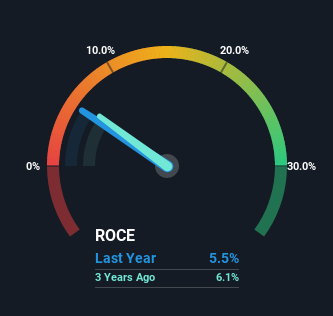- United States
- /
- Healthtech
- /
- NasdaqGS:NXGN
These Return Metrics Don't Make NextGen Healthcare (NASDAQ:NXGN) Look Too Strong

What financial metrics can indicate to us that a company is maturing or even in decline? When we see a declining return on capital employed (ROCE) in conjunction with a declining base of capital employed, that's often how a mature business shows signs of aging. Ultimately this means that the company is earning less per dollar invested and on top of that, it's shrinking its base of capital employed. And from a first read, things don't look too good at NextGen Healthcare (NASDAQ:NXGN), so let's see why.
What Is Return On Capital Employed (ROCE)?
For those who don't know, ROCE is a measure of a company's yearly pre-tax profit (its return), relative to the capital employed in the business. Analysts use this formula to calculate it for NextGen Healthcare:
Return on Capital Employed = Earnings Before Interest and Tax (EBIT) ÷ (Total Assets - Current Liabilities)
0.055 = US$25m ÷ (US$627m - US$169m) (Based on the trailing twelve months to September 2022).
Thus, NextGen Healthcare has an ROCE of 5.5%. Ultimately, that's a low return and it under-performs the Healthcare Services industry average of 7.3%.
Our analysis indicates that NXGN is potentially undervalued!

In the above chart we have measured NextGen Healthcare's prior ROCE against its prior performance, but the future is arguably more important. If you'd like, you can check out the forecasts from the analysts covering NextGen Healthcare here for free.
What The Trend Of ROCE Can Tell Us
We are a bit worried about the trend of returns on capital at NextGen Healthcare. To be more specific, the ROCE was 9.8% five years ago, but since then it has dropped noticeably. Meanwhile, capital employed in the business has stayed roughly the flat over the period. Since returns are falling and the business has the same amount of assets employed, this can suggest it's a mature business that hasn't had much growth in the last five years. If these trends continue, we wouldn't expect NextGen Healthcare to turn into a multi-bagger.
In Conclusion...
In summary, it's unfortunate that NextGen Healthcare is generating lower returns from the same amount of capital. But investors must be expecting an improvement of sorts because over the last five yearsthe stock has delivered a respectable 55% return. Regardless, we don't feel too comfortable with the fundamentals so we'd be steering clear of this stock for now.
Like most companies, NextGen Healthcare does come with some risks, and we've found 1 warning sign that you should be aware of.
While NextGen Healthcare may not currently earn the highest returns, we've compiled a list of companies that currently earn more than 25% return on equity. Check out this free list here.
Valuation is complex, but we're here to simplify it.
Discover if NextGen Healthcare might be undervalued or overvalued with our detailed analysis, featuring fair value estimates, potential risks, dividends, insider trades, and its financial condition.
Access Free AnalysisHave feedback on this article? Concerned about the content? Get in touch with us directly. Alternatively, email editorial-team (at) simplywallst.com.
This article by Simply Wall St is general in nature. We provide commentary based on historical data and analyst forecasts only using an unbiased methodology and our articles are not intended to be financial advice. It does not constitute a recommendation to buy or sell any stock, and does not take account of your objectives, or your financial situation. We aim to bring you long-term focused analysis driven by fundamental data. Note that our analysis may not factor in the latest price-sensitive company announcements or qualitative material. Simply Wall St has no position in any stocks mentioned.
About NasdaqGS:NXGN
NextGen Healthcare
NextGen Healthcare, Inc. provides healthcare technology solutions in the United States.
Adequate balance sheet with moderate growth potential.
Similar Companies
Market Insights
Community Narratives



